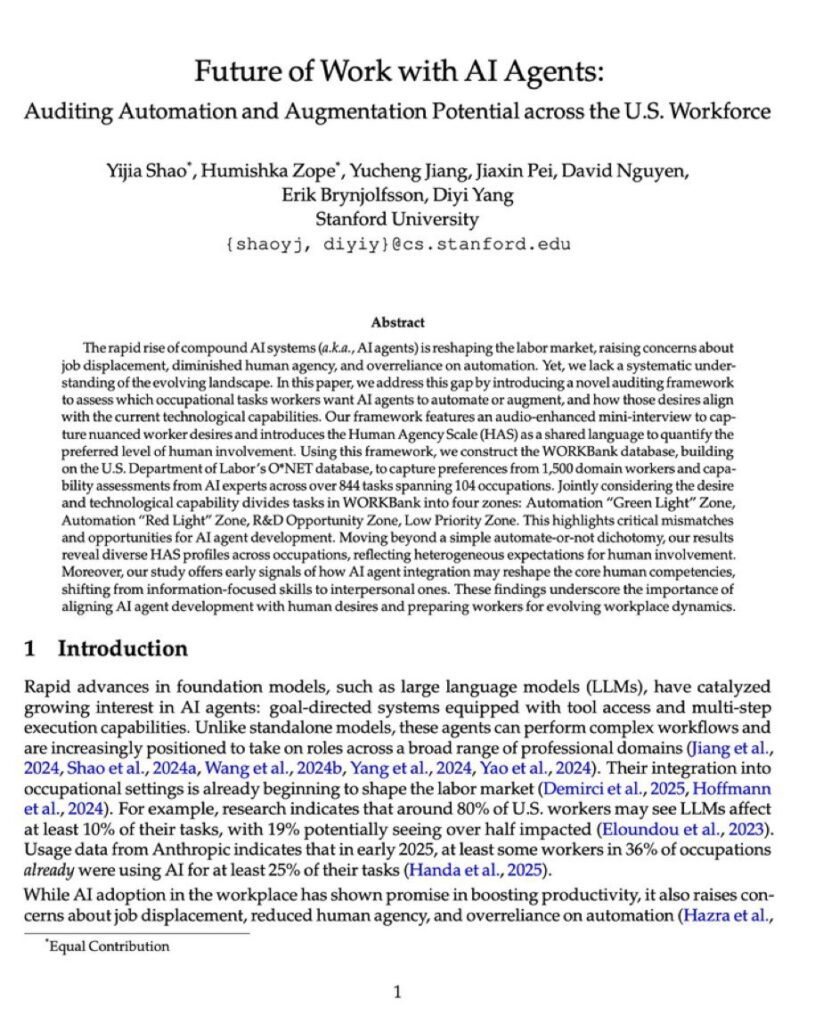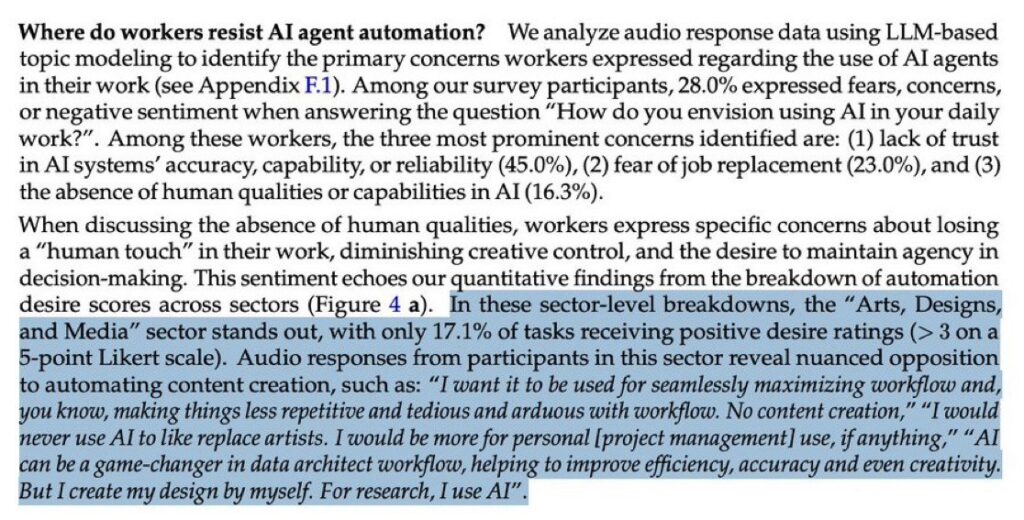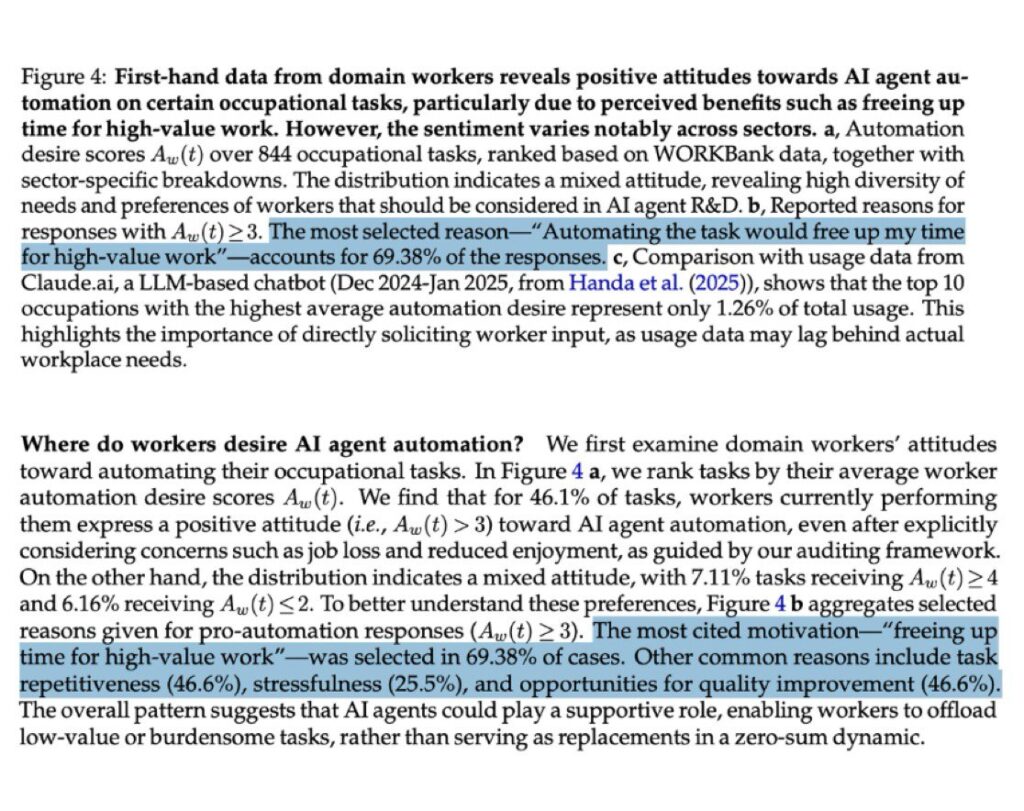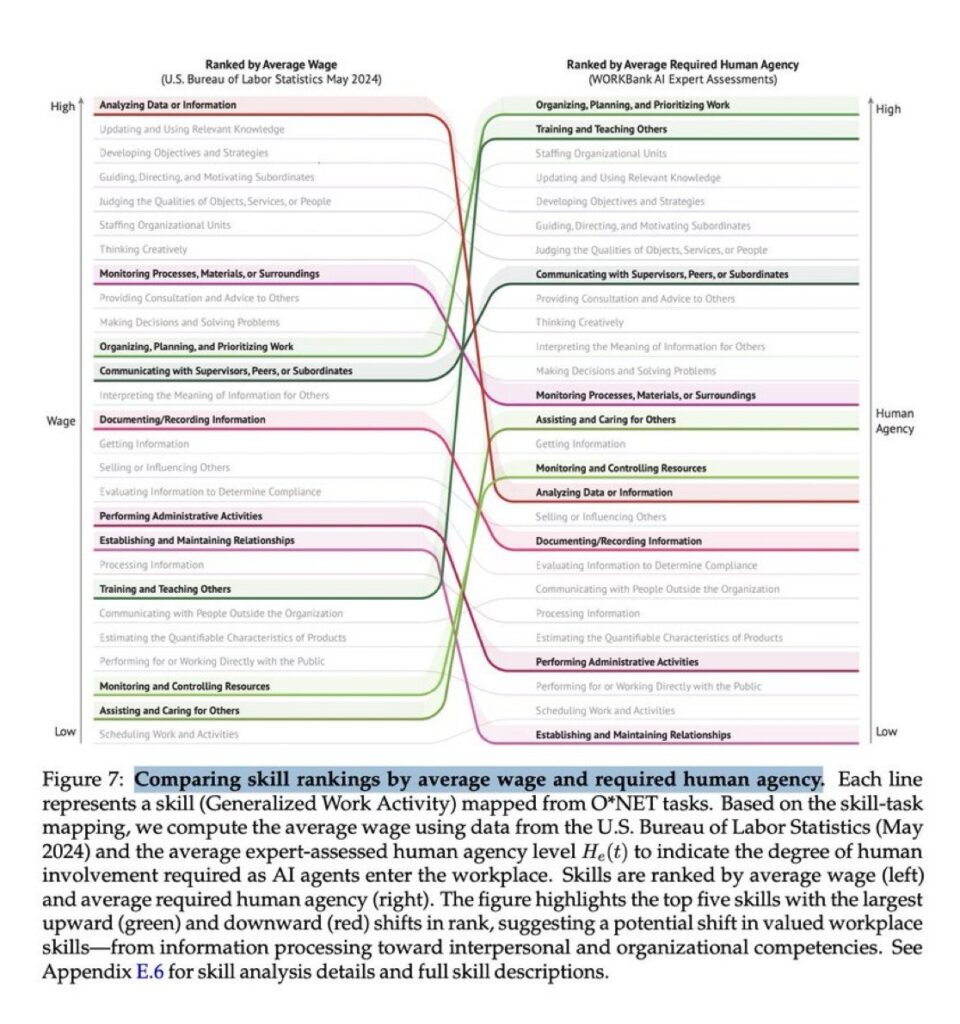The artificial intelligence revolution is unfolding at its own pace. While tech companies race to build fully autonomous AI systems, a groundbreaking Stanford study of 1,500 workers and AI experts reveals a fundamental disconnect: we’ve been building AI for all the wrong jobs.
The research Future of Work With AI Agents exposes a startling reality, as it seems that workers don’t want AI replacements (and who would?)
What a surprise, workers want AI as partners. And this shift toward human-AI collaboration represents the greatest opportunity in the custom LLM training space today.
The Great AI Misalignment
Stanford’s comprehensive analysis divided AI adoption into four distinct zones based on worker desire versus technical capability.
The findings are striking: 41% of startup investments are flowing into areas workers actively resist or where AI capabilities remain limited.
Meanwhile, the “Green Light” zone where workers desperately want AI assistance remains largely underserved. This misalignment reveals why so many AI implementations fail to gain traction despite impressive technical capabilities.
The data tells a clear story: 46.1% of tasks received positive automation ratings, but workers consistently prefer “H3 equal partnership” over full replacement. Surprisingly, no one voted for unemployment, but instead for intelligent collaboration.
Why Custom LLM Training is the Solution
This is where custom LLM training and fine-tuning become game-changers. Unlike generic AI models that attempt one-size-fits-all automation, custom-trained LLMs can be precisely calibrated to support the partnership model workers actually want.
Custom training allows organizations to create AI systems that understand:
Context-Specific Workflows: A custom-trained LLM learns your organization’s unique processes, terminology, and decision-making patterns. Instead of forcing workers to adapt to generic AI, the AI adapts to them.
Role-Based Collaboration: The Stanford study found that 23% of workers want “role-based support”. In most cases, that’s AI that acts like a specialized teammate rather than a replacement. Custom training enables this by creating AI assistants tailored to specific professional roles and responsibilities.
Cultural Alignment: Workers’ resistance to AI often stems from fear of obsolescence. Custom-trained models can be designed from the ground up to augment human capabilities rather than replace them, building trust through demonstrated partnership.
The Creative Industry Lesson
The creative sector provides a perfect case study. Only 17% of creative tasks received positive automation ratings in the Stanford survey, with workers drawing a hard line: Automate my boring stuff, not my creative work.
Custom LLM training addresses this precisely. Instead of attempting to replace creative decision-making, fine-tuned models can handle:
- Administrative workflows that consume creative time
- Research and information gathering
- Initial draft generation that humans refine
- Technical implementation of creative concepts
As one art director in the study noted: “I want workflow maximized, not content creation.” Custom training makes this distinction possible.
Building Trust Through Intelligent Partnership
The Stanford research revealed that trust matters more than capability. Workers’ top concerns about AI center on losing control and agency in their work. Custom LLM training directly addresses these fears by creating systems that enhance rather than threaten human expertise.
Transparent Decision-Making: Custom models can be trained to explain their reasoning in domain-specific language that workers understand and trust.
Gradual Capability Expansion: Fine-tuning allows for incremental improvement, letting workers build confidence in AI partnership over time.
Domain Expertise: Custom training creates AI that speaks the language of specific industries and roles, demonstrating understanding rather than imposing generic solutions.
The Wage Reversal and Human Premium Skills
Stanford identified a significant shift in skill valuation: “analyzing data” capabilities are declining in value while “interpersonal skills” and “training others” are becoming premium competencies. This trend reinforces why the partnership model is economically superior to replacement.
Custom LLM training supports this transition by:
- Handling routine analytical tasks so humans can focus on relationship-building
- Providing personalized coaching and development recommendations
- Enabling more effective human-to-human communication by reducing administrative overhead
The Implementation Framework
Organizations seeking to implement partnership-focused AI should consider this framework based on the Stanford findings:
Phase 1: Identify Partnership Opportunities Map current workflows against the Human Agency Scale (H1-H5), focusing on H3 equal partnership zones where custom AI can add immediate value.
Phase 2: Custom Training Design Develop training datasets that reflect your organization’s collaboration preferences, not just task completion patterns.
Phase 3: Iterative Refinement Use feedback loops to continuously adjust the AI’s collaboration style based on worker satisfaction and productivity metrics.
Phase 4: Trust Building Implement transparency features that help workers understand and influence AI decision-making processes.
The Market Opportunity
The disconnect between current AI development and worker needs represents a massive market opportunity. While competitors chase full automation, organizations using custom LLM training to build intelligent partnerships will capture the 69.38% of workers who want to “focus on high-value work.”
Productivity aside, it’s more about creating sustainable competitive advantages through enhanced human-AI collaboration.
The Future is Partnership, Not Replacement
The Stanford study’s most important finding reveals a lot about human nature. More than being outsmarted and outperformed by AI, workers are afraid to lose purpose and agency in their work.
Custom LLM training offers a path forward that honors both human creativity and AI capability. By building systems that enhance rather than replace human expertise, organizations can tap into the true potential of artificial intelligence while maintaining the trust and engagement of their workforce.
The AI revolution is indeed happening backwards from expectations. The winners won’t be those who build the most autonomous systems, but those who create the most intelligent partnerships.
The future of work isn’t humans versus AI. It’s humans with AI, and custom LLM training is the bridge that makes it possible.
Boris is an AI researcher and entrepreneur specializing in deep learning, model compression, and knowledge distillation. With a background in machine learning optimization and neural network efficiency, he explores cutting-edge techniques to make AI models faster, smaller, and more adaptable without sacrificing accuracy. Passionate about bridging research and real-world applications, Boris writes to demystify complex AI concepts for engineers, researchers, and decision-makers alike.
- Boris Sorochkinhttps://kdcube.tech/author/boris/
- Boris Sorochkinhttps://kdcube.tech/author/boris/
- Boris Sorochkinhttps://kdcube.tech/author/boris/
- Boris Sorochkinhttps://kdcube.tech/author/boris/








